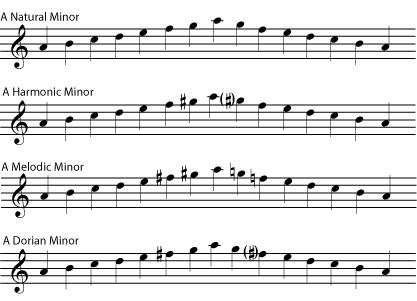If we talk about the most common frets, then from the point of view of music theory, a minor is a fret that has a kind of sad tinge. This color is given to him by the combination of minor third and pure fifth in the construction of triads and arpeggios. In this case, a small third is constructed from a tonic note, and then a large third is added to the interval. As a result, between the tonic and the dominant, a pure fifth is obtained.
Minor and its meaning
The meaning of the word “minor” is inextricably linked with its interpretation from the point of view of the Latin language. After all, it came from there. Minor is a word derived from the Latin “molls”, which literally can be translated as “soft” or “sad”. It is not surprising that the designation of minor keys is done by adding the word “moll” to the tonic. For example, C-moll (C minor).
Varieties of minor
Minor keys have three main varieties: natural, harmonic and melodic minor. The construction of the gamma in each case differs regardless of which key signs the tonality uses.
In a natural minor, gamma performance only involves signs in a key. Harmonic minor is a gamma with an increased seventh step, and a melodic minor has an increase in two steps at once (sixth and seventh) and is played in different sequences up and down. That is, when playing in an ascending order, these steps increase. In the reverse order, the “baker” sign is used for them, and the notes sound in their pure form. This standard rule applies to all sharp or flat keys, as well as to the only minor key that does not contain the A-moll key characters.

By the way, to simplify the notation, the full name of the minor is often not used, and the small letter “m” is simply added to the main tonic note in the Latin version. If you give the simplest example based on such an abbreviation, then the same "E-minor" will look like "Em". It is very simple and convenient. It goes without saying that to denote keys of the “C sharp minor” type, you can use the designations of the type “C # m” or “Cis-moll”. The second category of designations is used extremely rarely. The simplest abbreviation is enough.
The most common minor scales
The most common and most commonly used are minor keys with tonics on the notes “la” and “mi”. In this case, a minor is a gamma containing a minimum of key characters. In the minor scale "la" in the key they are not at all. In “E-minor” there is only “F-sharp”. It is thanks to the simplicity of the scale and construction of the main triads, these minors are most common among pianists and guitarists.
For both instruments, the chord technique is the simplest and is part of the initial music training course. For the guitar, one can also single out the “D minor”, the chord of which is basic for playing with just three fingers, as well as the “A minor”. E-minor uses only two fingers, which press the fourth and fifth strings in the second fret.
Lyric characteristics of minor
Minor keys are distinguished by the fact that they give a musical work a mournful coloring or even some lyrical notes. In combination with the main steps of the scale and parallel majors, they can cause a storm of emotions, which is simply impossible to convey in words. If you look at it, most of the musical ballads or slow compositions are presented precisely in minor keys. This is understandable, because a deep feeling is transmitted only in this way. One has only to hear the initial chords, as the soul immediately plunges into awe.
Of course, the matter is not limited to a combination of standard harmonies and chords. For example, Pink Floyd’s use of enlarged and reduced triads adds a simply indescribable effect of psychedelic style to the composition. For any musician, the use of minor keys gives a wide field for creativity, despite the seven standard notes of the scale.